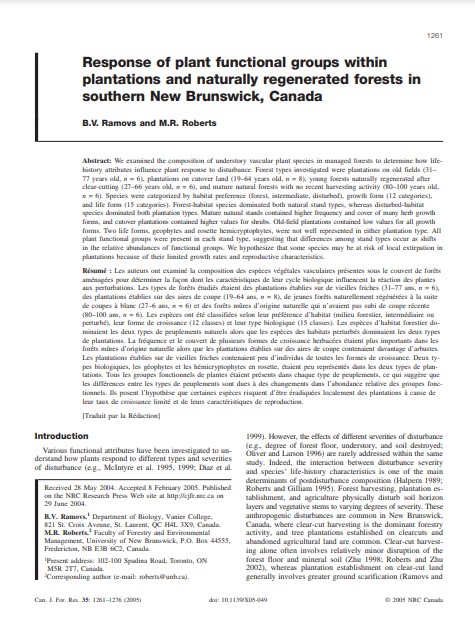Response of plant functional groups within plantations and naturally regenerated forests in southern New Brunswick, Canada
Bosque Modelo:
Fundy
Temática:
Conservación
Tipo de documento:
Artículo científico
Resumen
We examined the composition of understory vascular plant species in managed forests to determine how lifehistory attributes influence plant response to disturbance. Forest types investigated were plantations on old fields (31– 77 years old, n = 6), plantations on cutover land (19–64 years old, n = 8), young forests naturally regenerated after clear-cutting (27–66 years old, n = 6), and mature natural forests with no recent harvesting activity (80–100 years old, n = 6). Species were categorized by habitat preference (forest, intermediate, disturbed), growth form (12 categories), and life form (15 categories). Forest-habitat species dominated both natural stand types, whereas disturbed-habitat species dominated both plantation types. Mature natural stands contained higher frequency and cover of many herb growth forms, and cutover plantations contained higher values for shrubs. Old-field plantations contained low values for all growth forms. Two life forms, geophytes and rosette hemicryptophytes, were not well represented in either plantation type. All plant functional groups were present in each stand type, suggesting that differences among stand types occur as shifts in the relative abundances of functional groups. We hypothesize that some species may be at risk of local extirpation in plantations because of their limited growth rates and reproductive characteristics.
Información Bibliográfica
Autor:
Ramovs, BV and MR Roberts.
Revista:
Canadian Journal of Forest Research
Año:
2005
N°:
-
País :
Canadá
Páginas:
1261 - 1276
Volumen:
35
Idioma:
Ingles
Palabras claves
Model forest, Adaptatation, Canada





